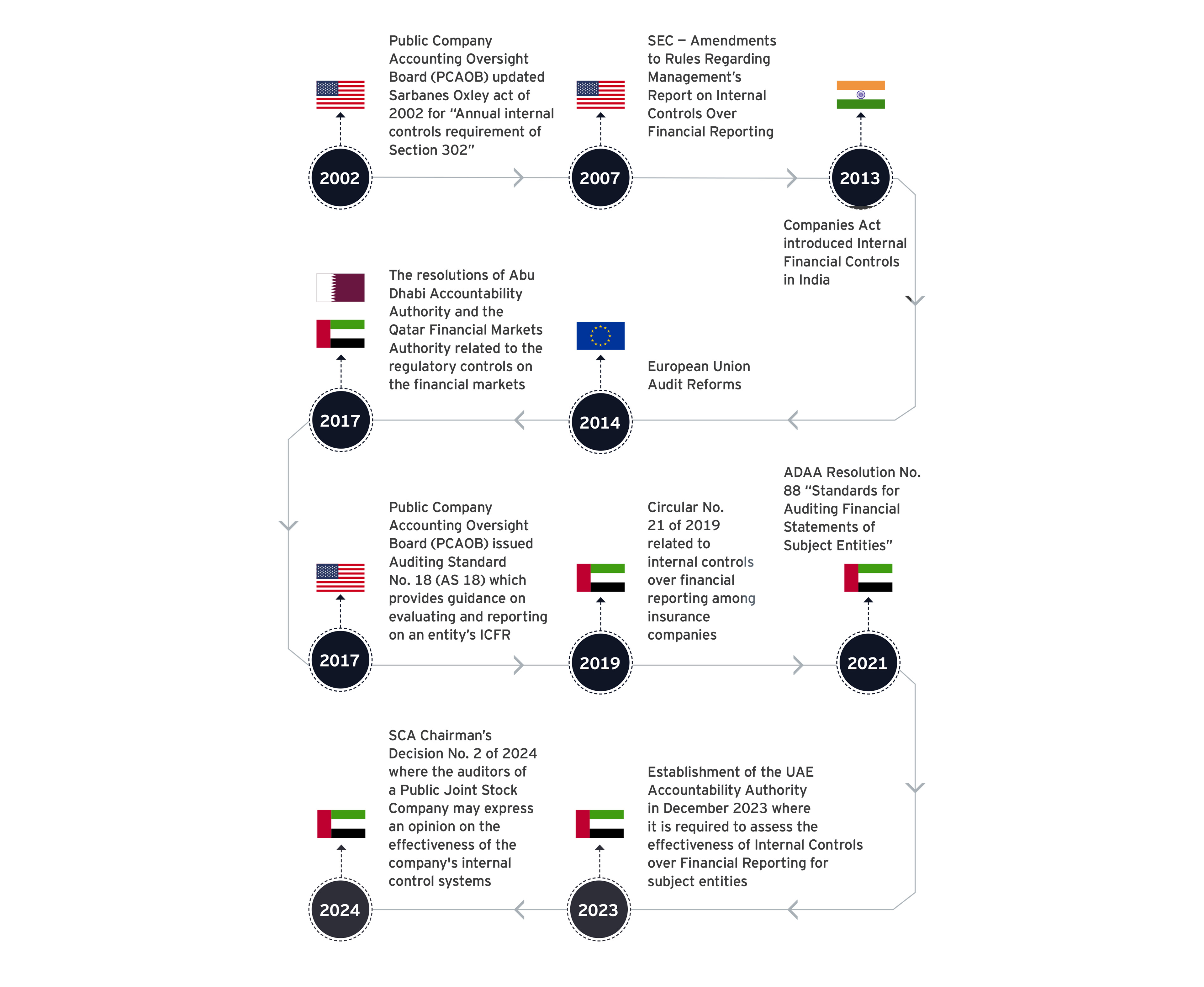
Chapter 1
Evolution of corporate governance
Reimagining governance as an overall umbrella for the investment landscape.
The concept of corporate governance has evolved over centuries, balancing between the roles and responsibilities of boards, executive management and shareholders, and aiming to prevent conflict and mitigate the risks associated with the principal-agent problem. In essence, corporate governance can be defined as a framework of principles that govern organizations, ensuring a consistent and disciplined relationship among the board, management, shareholders and other stakeholders.
In the early 2000s, a significant turning point in this evolution occurred when global accounting scandals prompted a thorough reassessment of corporate governance practices. Investors and regulators joined forces in demanding the implementation of robust corporate governance frameworks that prioritize stakeholder inclusivity, sustainability and ethical considerations, all with the aim of boosting stakeholders’ trust.1 As a result, numerous corporate governance standards emerged in the past 20 years as detailed by the examples below:

This evolution in corporate governance was not limited only to listed entities but was also adopted by government entities. A prime example is the 2020 UAE Federal Government issuance of the Guide to Board Governance in the UAE Federal Government covering all Federal Government entities in the UAE. This groundbreaking measure, a first of its kind in the MENA region, is aimed at organizing the activities of boards of directors in line with leading international standards and the strategic objectives of the UAE government. Such initiatives are crucial in boosting stakeholder trust in the government and public sector, providing a positive perception to investors and serving as an indicator of governance maturity in these economies.
Such regulations, backed by leading standards as illustrated in the figure above, enhances government credibility in the eyes of investors and global rating agencies. One major regulatory development is the Worldwide Governance Indicators (WGI), which help investors and analysts evaluate the governance practices across countries globally. Its main aim is to assess the quality of governance in countries, covering dimensions like government effectiveness and control over corruption, with scores based on diverse data sources produced by over 30 organizations worldwide. It is published by the World Bank and provides country rankings based on assessed governance quality.2 Such leading indicators serve as a valuable tool for investors to judge and compare the maturity of governance frameworks internationally.
In conclusion, the evolution of corporate governance has been a dynamic and essential process, aimed at establishing equilibrium among the key players in organizations while mitigating the principal-agent problem. Notably, governments have also embraced this evolution, exemplified by the MENA-OECD Initiative on Governance and Competitiveness for Development initiated and led within the region itself.3 Such initiatives increase stakeholders' trust and encourage FDI, driving economic growth. These regulations, aligned with leading international standards, enhance credibility and are key differentiators in assessments like the WGI, influencing investors' decision-making. Furthermore, effective governance includes robust succession planning, particularly vital for family businesses in the MENA region transitioning from a family to a corporate culture. As family businesses continue to play a substantial role in the region's economies, their presence in stock markets is contributing significantly to the nations’ GDP. This underlines the enduring importance of addressing capital market expectations and requirements through the implementation of sound governance principles.

Chapter 2
Transparent financial reporting
Solid control environment fostering transparency and trust.
As governments constantly undertake efforts to spur growth and innovation through FDI, they cannot neglect one crucial aspect — implementation of a robust set of laws and regulations emphasizing transparent and reliable financial reporting.4 Reliable reporting establishes the blueprint for a trustworthy and credible local and global financial environment, providing assurance to investors seeking to invest their economic wealth across the globe.
The journey toward transparent and reliable financial reporting emerges through the evolution of accounting principles and the pursuit of openness in disclosing financial information. Originating from the double-entry bookkeeping system in the 15th century, the concept gained prominence with the 17th century rise of joint stock companies, which prompted the use of disclosure to attract investors.
The early 20th century witnessed the introduction of securities regulations, such as the U.S. Securities Act of 1933 and the Securities Exchange Act of 1934, establishing a legal framework for financial transparency.5 The Enron scandal in the early 2000s was a pivotal event which spurred the enactment of the Sarbanes-Oxley Act (SOX) in 2002, emphasizing internal controls and accountability. Recently, the focus has expanded to include sustainability reporting, reflecting a broader perspective on organizational transparency and accountability. The timeline below outlines the ICFR journey globally as a response to various scandals across the US, India, Europe and the Middle East. Those moments of crisis allowed regulators to issue various laws and resolutions pertaining to ICFR implementation.

Economic and financial turbulence calls for greater transparency from governments and policymakers. In order to sustain this climate of transparency, governments are striving to implement regulations that promote accountability and effective decision-making. The introduction of ICFR in the US through the 2002 passage of SOX came in response to accounting scandals, such as those at Enron and WorldCom, which eroded public trust in internal corporate controls over financial reporting. An ineffective internal control ecosystem may prompt investors to shift their focus to countries with stronger regulatory frameworks and more transparent financial systems. ICFR stands out as a solid element of enhanced corporate accountability, transparency and accuracy in financial reporting. It represents a significant regulatory measure to protect investors and restore confidence in the financial markets.
Consider the fact that Denmark, Finland and New Zealand — recognized as the least corrupt countries in the world6 — all established a set of robust laws and regulations to enforce ICFR implementation in public joint-stock companies. This reform of their financial systems ultimately led to a revolutionary transformation in the way transparency is practiced. These measures include Companies Acts in both Denmark7 and Finland8 as well as the Public Finance Act9 in New Zealand, requiring companies, represented by their boards of directors, to establish and maintain proper internal control systems to safeguard their financial reporting processes as well as maintaining proactive initiatives to prevent fraud, errors and irregularities in financial reporting.
The observed benefits of implementing such standards in Europe and New Zealand drove governments in the Middle East, especially in the UAE, to adopt similar acts such as Abu Dhabi Accountability Authority (ADAA) Resolution No.1 of 2017, which requires all subject entities’ external auditors to issue a separate report including an assessment on the effectiveness of the internal control systems.10
Besides the government’s role in introducing regulations and driving this agenda, international organizations such as the IMF have been key players in encouraging transparency in both government and the private sector to facilitate global FDI. The IMF examines areas such as fiscal transparency, anti-corruption and rule of law, all of which contribute to providing investors access to accurate and reliable information about the country’s economic conditions, risks and potential opportunities.11 This helps countries enhance their competitiveness in the global market.
Further, ICFR is a critical enabler for governments in their privatization initiatives. ICFR can help facilitate a smoother privatization journey by enhancing credibility and reliability, ensuring regulatory compliance and creating a more attractive proposition for potential investors.
In summary, attracting FDI and nurturing economic growth and innovation hinges upon the establishment of robust regulatory frameworks that prioritize transparent and dependable financial reporting. This foundation underpins a trustworthy and credible financial environment, offering reassurance to investors who seek to expand their investment portfolio globally. Economic challenges underscore the need for governments and policymakers to enhance transparency, and the introduction of ICFR has revolutionized transparency standards. The adoption of similar measures in the Middle East, exemplified by ADAA, marks a significant step toward privatization and accountability. International organizations play a vital role in fostering transparency and attracting FDI, thus promoting global economic resilience and competitiveness through adherence to international standards and best practices. Together, these efforts pave the way for a more secure and prosperous global economic landscape.

Chapter 3
ESG principles
The evolution of ESG and its influence on governments and communities.
The genesis of the ESG investing concept came about in the 1960s through the principle of socially responsible investing. During that period, investors performed negative screening to exclude stocks or entire industries from their portfolios due to their involvement in activities such as tobacco production or ties to the South African apartheid system. Recently, the importance of ESG has been emphasized for the first time by world leaders, as shown by the Paris Agreement12 and its revolutionary step of adopting a unified framework to combat climate change and adapt to its effects.
Further, this was also re-emphasized by the world’s leadership during COP28 which was recently held in the UAE. Since then, the significance of ESG has only risen, with ESG components becoming fundamental criteria playing a pivotal role in reinforcing investors’ confidence in governments, economies and financial markets. This interconnectedness between ESG and investor confidence underscores the vital link between sustainable practices and overall economic stability.
This profound shift, underscored by several key factors, has seen governments and their regulatory bodies advancing the ESG agenda. Their commitment is manifested in the implementation of robust ESG regulations aimed explicitly at mitigating risks inherent in environmental challenges, societal dynamics and governance frameworks.
Many countries’ capital market authorities have mandated sustainability reporting, emphasizing the importance of using international standards such as ISO 26000 (social responsibility) and the Global Reporting Initiative (GRI). These regulations or frameworks help governments and regulatory bodies foster an environment of standardized and dynamic ESG operating models, which is vital for wooing investors and setting clear guidelines and expectations for market players (i.e., corporations and financial institutions) in the economy.13
Market players have adjusted to these new governmental initiatives and regulations. To become effective partners in government efforts to achieve national ESG goals, market players must integrate sophisticated ESG practices into their financial and operational strategies. Whether by adopting sustainable business standards, reducing carbon footprints, becoming flag-bearers for diversity and inclusion, or by maintaining robust governance frameworks, market players have undertaken action to adopt these ESG practices.14 By proactively engaging, market players not only enhance the credibility of the ESG agenda but also establish themselves as benchmarks for leading ESG practices.
Investors, along with other stakeholders, are instrumental in advancing ESG considerations. They demand those businesses incorporate ESG in their daily activities and fulfil their corporate social responsibility (CSR). ESG acts as a key pillar for consideration before embarking into any investment, driving investors to meticulously assess how companies navigate the triad of ESG challenges and initiatives. Companies that don't measure up to these ESG standards often find themselves at risk of investor activism, ranging from pressure on corporate leadership to divestment to replacing senior management with a team willing to lead on ESG.
Underpinning these ESG dynamics is a formidable legal structure set and imposed by governments and regulators on market participants to govern the overall relationship among all involved stakeholders. This enabler is crucial to ensure the longevity and effectiveness of any ESG initiative. A national legal framework addressing the full spectrum of ESG considerations from environmental preservation to workers' rights and from corporate governance to ethical business practices, serves as a rigorous benchmark for corporate ESG adherence.15
In short, the success of ESG initiatives relies on harmonious collaboration between governments, market players and investors. Their collective endeavors create a magnetic pull for FDI, with both institutional and individual investors attracted to nations that exhibit a deep commitment to ESG tenets. The resulting investment inflow, in turn, has the power to boost national GDP and spur economic growth.
In conclusion, governments can reshape their economies' future by anchoring on three key strategies: strengthening corporate governance, embracing transparent and dependable financial reporting, and integrating robust ESG practices. This return on investment includes a favorable climate for investor confidence, as well as maintaining and preserving the continuous inflow of FDI. By safeguarding these fundamentals for sustainable economic growth, governments can also secure an agile and promising future where privatization, corporatization and IPOs propel national economies toward ever-increasing heights.
Forward-thinking governments willing to create and sustain an attractive environment not only introduce and impose the necessary regulations, but also lead and implement the following top three initiatives:
- Pioneering consistent but dynamic governance, ICFR and ESG frameworks that reinforce concepts of responsibility, transparency, reliability and accountability while minimizing bottlenecks for effective and informed decision-making
- Raising awareness and building capability around the interconnection of the three principles as well as the positive correlation between them and the nation’s economic prosperity
- Sustaining distinctive ecosystems that foster a culture of creativity and innovation, utilizing the lessons of the past to shape a brighter tomorrow for future generations
Related articles
Summary
Privatization strategy in a globally integrated world economy fosters growth through the creation of attractive environments for FDI. Solid corporate governance, transparent and reliable financial reporting through Internal Control over Financial Reporting, and strong ESG practices are integral to this process. Governments can boost their credibility and financial health, making them more appealing for FDI, by embracing privatization. Through commitment to these principles and by facilitating the privatization process, governments create a favorable climate for sustained FDI and long-term economic value creation.


